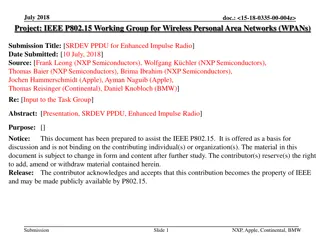
CS255 Winter 2025 Recap: Block Ciphers and AES Encryption
Explore the fundamentals of block ciphers and AES encryption in CS255 Winter 2025 with Dan Boneh from Stanford University. Learn about key concepts such as key expansion, iteration, and the AES-NI hardware instructions for efficient encryption and decryption. Dive into how block ciphers are built by iteration and the specifics of AES encryption with different key lengths. Discover the AES encryption process with Even-Mansour ciphers and the advantages of using AES-NI for faster encryption on compatible hardware.
Download Presentation

Please find below an Image/Link to download the presentation.
The content on the website is provided AS IS for your information and personal use only. It may not be sold, licensed, or shared on other websites without obtaining consent from the author. If you encounter any issues during the download, it is possible that the publisher has removed the file from their server.
You are allowed to download the files provided on this website for personal or commercial use, subject to the condition that they are used lawfully. All files are the property of their respective owners.
The content on the website is provided AS IS for your information and personal use only. It may not be sold, licensed, or shared on other websites without obtaining consent from the author.
E N D
Presentation Transcript
CS255: Winter 2025 PRPs and PRFs Dan Boneh, Stanford University 1
Recap Simple stream ciphers: can only use key to encrypt one message Next goal: ciphers where a single key can be used to encrypt many messages First, block ciphers 2
Quick Recap A block cipher is a pair of efficient algs. (E, D): n bits n bits E, D PT Block CT Block Key k bits Canonical examples: 1. AES: n=128 bits, k = 128, 192, 256 bits 2. 3DES: n= 64 bits, k = 168 bits (historical)
Block Ciphers Built by Iteration key k key expansion k1 k2 k3 kn c m R(kn, ) R(k3, ) R(k2, ) R(k1, ) R(k,m) is called a round function 3DES: n=48, AES128: n=10, AES256: n=14
AES: an iterated Even-Mansour cipher single round EM ? ? ? input invertible ?0 ?1 ?2 ?? 1 ?? output key key expansion: ?: {0,1}? {0,1}? invertible function
AES256: 14 rounds of EM last round 14 rounds 4 (1) ByteSub (2) ShiftRow (1) ByteSub (2) ShiftRow (3) MixColumn (1) ByteSub (2) ShiftRow (3) MixColumn 4 input invertible k0 k1 k2 k13 16-byes 16-bytes k14 4 output key 4 key expansion: 16 bytes 240 bytes 32 bytes (256 bits)
AES-NI: AES hardware instructions AES instructions (Intel, AMD, ARM, ) aesenc, aesenclast: do one round of AES 128-bit registers: xmm1=state, xmm2=round key aesenc xmm1, xmm2 ; puts result in xmm1 aesdec, aesdeclast: one round of AES-1 aeskeygenassist: performs AES key expansion Claim 1: 20 x speed-up over OpenSSL on same hardware Claim 2: constant time execution
AES-NI: Encrypting one block (AES256) step 0: aeskeygenassist(256-bit key) round keys in xmm2, xmm3, , xmm16 step 1: load plaintext block into xmm1(128-bit block) xor xmm1, xmm2 step 2: aesenc xmm1, xmm3 aesenc xmm1, xmm4 15 instructions aesenc xmm1, xmm5 aesenclast xmm1, xmm16
AES-NI: parallelism and pipelining Intel Skylake (old): 4 cycles for one aesenc fully pipelined: can issue one instruction every cycle Intel Icelake: vectorized aesenc (vaesenc) vaesenc: compute aesenc on four blocks in parallel fully pipelined Implications: AES256 encrypt a single block takes 56 cycles (14 rounds) AES256 encrypt 16 blocks on Icelake takes 59 cycles 12
AES256 encrypt on Icelake To encrypt 16 blocks do: m0, , m15 {0,1}128 0: m0 m1 m2 m3 (vaesenc -- 512 bit register zmm1) (vaesenc) 1: m4 m5 m6 m7 2: (vaesenc) m8 m9 m10 m11 3: (vaesenc) m12 m13 m14 m15 (4 cycles) 4: (vaesenc) m0' m1 m2 m3 m4 m5 m6 m7 5: (vaesenc) finish all 14 rounds after 59 cycles cycles 13
Abstract view of a block cipher: PRPs and PRFs Topics: 1. Abstract block ciphers: PRPs and PRFs 2. Security models for encryption 3. Analysis of CBC and counter mode 14
PRPs and PRFs Pseudo Random Function (PRF) defined over (K,X,Y): F: K X Y such that exists efficient algorithm to evaluate F(k,x) Pseudo Random Permutation (PRP) defined over (K,X): E: K X X such that: 1. Exists efficient algorithm to evaluate E(k,x) 2. The function E( k, ) is one-to-one 3. Exists efficient inversion algorithm D(k,x) 15
Running example Example PRPs: 3DES, AES, AES256: K X X where X = {0,1}128, K = {0,1}256 3DES: K X X where X = {0,1}64, K = {0,1}168 Functionally, any PRP is also a PRF. A PRP is a PRF where X=Y and is efficiently invertible A PRP is sometimes called a block cipher 16
Secure PRFs Let F: K X Y be a PRF Funs[X,Y]: the set of all functions from X to Y SF = { F(k, ) s.t. k K } Funs[X,Y] Intuition: a PRF is secure if a random function in Funs[X,Y] is indistinguishable from a random function in SF SF Funs[X,Y] Size |K| |X| Size |Y| 17
Secure PRFs Let F: K X Y be a PRF Funs[X,Y]: the set of all functions from X to Y SF = { F(k, ) s.t. k K } Funs[X,Y] Intuition: a PRF is secure if a random function in Funs[X,Y] is indistinguishable from a random function in SF f Funs[X,Y] x X ??? f(x) or F(k,x) ? k K
Secure PRF: defintion For b=0,1 define experiment EXP(b) as: b b=0: k K, f F(k, ) b=1: f Funs[X,Y] Chal. Adv. ? xi X f(xi) b {0,1} Def: F is a secure PRF if for all efficient ? : is negligible. AdvPRF[?,F] = |Pr[EXP(0) = 1] Pr[EXP(1) = 1] | 19
An example Let K = X = {0,1}n . Consider the PRF: F(k, x) = k x defined over (K, X, X) Let s show that F is insecure: Adversary ? : (1) choose arbitrary x0 x1 X (2) query for y0 = f(x0) and y1 = f(x1) (3) output `0 if y0 y1 = x0 x1 , else `1 Pr[EXP(0) = 0]= 1 Pr[EXP(1) = 0]= 1/2n AdvPRF[?,F] = 1 (1/2?) (not negligible) 20
Secure PRP For b=0,1 define experiment EXP(b) as: b b=0: k K, f E(k, ) b=1: f Perms[X] Chal. Adv. ? xi X f(xi) b {0,1} Def: E is a secure PRP if for all efficient ? : is negligible. AdvPRP[?,E] = |Pr[EXP(0) = 1] Pr[EXP(1) = 1] | 21
Example secure PRPs Example secure PRPs: 3DES, AES, AES256: K X X where X = {0,1}128 K = {0,1}256 AES256 PRP Assumption (example) : For all ? s.t. time(?) < 280 : AdvPRP[?, AES256] < 2-40 22
The PRP-PRF Switching Lemma Any secure PRP is also a secure PRF. Lemma: Let E be a PRP over (K, X). Then for any q-query adversary ? : | AdvPRF[?,E] AdvPRP[?,E] | < q2 / 2|X| Suppose |X| is large so that q2/ 2|X| is negligible Then AdvPRP[?,E] negligible AdvPRF[?,E] negligible 23
Using PRPs and PRFs Goal: build secure encryption from a PRP 24
Incorrect use of a PRP Electronic Code Book (ECB): PT: m1 m2 c2 c1 CT: Problem: if m1=m2 then c1=c2 25
In pictures (courtesy B. Preneel) 26
How to use a block cipher? Modes of Operation for One-time Use Key Example application: Encrypted email. New key for every message. 27
Semantic Security for one-time key E = (E,D) a cipher defined over (K,M,C) For b=0,1 define EXP(b) as: b Chal. Adv. ? m0 , m1 M : |m0| = |m1| k K c E(k, mb) b {0,1} Def: E is sem. sec. for one-time key if for all efficient ? : is negligible. AdvSS[?,E] = |Pr[EXP(0)=1] Pr[EXP(1)=1] | 28
Semantic security (cont.) Sem. Sec. no efficient adversary learns info about PT from a single CT. Example: suppose efficient ? can deduce LSB of PT from CT. Then E = (E,D) is not semantically secure. b {0,1} m0, LSB(m0)=0 m1, LSB(m1)=1 Adv. B (us) Chal. k K Adv. ? (given) c E(k, mb) c LSB(mb)=b Then AdvSS[B, E] = 1 E is not sem. sec. 29
Note: ECB is not Sem. Sec. ECB is not semantically secure for messages that contain two or more blocks. b {0,1} Two blocks Chal. Adv. ? m0= Hello World m1= Hello Hello k K (c1,c2) E(k, mb) If c1=c2 output 1, else output 0 Then AdvSS[?, ECB] = 1 30
Secure Constructions Examples of sem. sec. systems: 1. AdvSS[?, OTP] = 0 for all? 2. Deterministic counter mode from a PRF F : EDETCTR (k,m) = m[0] m[1] m[L] F(k,0) F(k,1) F(k,L) indist. from a OTP c[0] c[1] c[L] Stream cipher built from PRF (e.g. AES) 31
Det. counter-mode security Theorem: For any L>0. If F is a secure PRF over (K,X,X) then EDETCTR is sem. sec. cipher over (K,XL,XL). In particular, for any adversary ? attacking EDETCTR there exists a PRF adversary B s.t.: AdvSS[?, EDETCTR] = 2 AdvPRF[B, F] AdvPRF[B, F] is negligible (since F is a secure PRF) AdvSS[?, EDETCTR] must be negligible. 32
Modes of Operation for Many-time Key Example applications: 1. File systems: Same AES key used to encrypt many files. 2. IPsec: Same AES key used to encrypt many packets. 33
Semantic Security for many-time key (CPA security) Cipher E = (E,D) defined over (K,M,C). For b=0,1 define EXP(b) as: for i=1, ,q: b {0,1} Chal. Adv. ? k K mi,0 , mi,1 M : |mi,0| = |mi,1| ci E(k, mi,b) b {0,1} if adv. wants c = E(k, m) it queries with mj,0= mj,1=m Def: Eis sem. sec. under CPA if for all efficient ? : is negligible. AdvCPA [?,E] = |Pr[EXP(0)=1] Pr[EXP(1)=1] |
Security for many-time key Fact: stream ciphers are insecure under CPA. More generally: if E(k,m) always produces same ciphertext, then cipher is insecure under CPA. m0 , m0 M c0 E(k, m0) Chal. Adv. k K m0 , m1 M output 0 if c = c0 c E(k, mb) If secret key is to be used multiple times given the same plaintext message twice, the encryption alg. must produce different outputs. 35
Nonce-based Encryption nonce Alice Bob D(k,c,n)=m c, n E(k,m,n)=c m, n E D k k nonce n: a value that changes from msg to msg (k,n) pair never used more than once method 1: encryptor chooses a random nonce, n N method 2: nonce is a counter (e.g. packet counter) used when encryptor keeps state from msg to msg if decryptor has same state, need not send nonce with CT 36
Construction 1: CBC with random nonce Cipher block chaining with a random IV (IV = nonce) IV m[0] m[1] m[2] m[3] E(k, ) E(k, ) E(k, ) E(k, ) IV c[0] c[1] c[2] c[3] ciphertext note: CBC where attacker can predict the IV is not CPA-secure. HW. 37
CBC: CPA Analysis CBC Theorem: For any L>0, If E is a secure PRP over (K,X) then ECBC is a sem. sec. under CPA over (K, XL, XL+1). In particular, for a q-query adversary A attacking ECBC there exists a PRP adversary B s.t.: AdvCPA[A, ECBC] 2 AdvPRP[B, E] + 2 q2 L2 / |X| Note: CBC is only secure as long as q2 L2 |X| # messages enc. with key max msg length 38
Construction 1: CBC with unique nonce Cipher block chaining with unique IV (IV = nonce) unique IV means: (key,IV) pair is used for only one message IV m[0] m[1] m[2] m[3] IV E(k1, ) E(k1, ) E(k1, ) E(k1, ) E(k2, ) IV c[0] c[1] c[2] c[3] ciphertext included only if unknown to decryptor 39
A CBC technicality: padding m[3] ll pad IV m[0] m[1] m[2] IV E(k, ) E(k, ) E(k, ) E(k, ) E(k1, ) IV c[0] c[1] c[2] c[3] pad is removed during decryption TLS 1.0: if need n-byte pad, n>0, use: n-1 n-1 n-1 if no pad needed, add a dummy block
Construction 2: rand ctr-mode F: PRF defined over (K,X,Y) where X = {0,1, ,2?-1} and Y = {0,1}? (e.g., n=128) msg IV m[0] m[1] m[L] F(k,IV) F(k,IV+1) F(k,IV+L) (counter counts mod 2?) IV c[0] c[1] c[L] ciphertext IV - chosen at random for every message note: parallelizable (unlike CBC) 41
Why is this CPA secure? the set X: domain of PRF IV3+1 IV3+L IV3 msg3 IV1 IV1+1 IV1+L msg1 msg5 IV2 IV2+1 IV2+L msg4 msg2 CPA security holds as long as intervals do not intersect q msgs, L blocks each Pr[ intersection ] 2 q2 L / |X| needs to be negligible 42
rand ctr-mode: CPA analysis Randomized counter mode: random IV. Counter-mode Theorem: For any L>0, If F is a secure PRF over (K,X,X) then ECTR is a sem. sec. under CPA over (K,XL,XL+1). In particular, for a q-query adversary A attacking ECTR there exists a PRF adversary B s.t.: AdvCPA[A, ECTR] 2 AdvPRF[B, F] + 2 q2 L / |X| Note: ctr-mode only secure as long as q2 L |X| Better then CBC ! 43
An example AdvCPA [A, ECTR] 2 AdvPRF[B, E] + 2 q2 L / |X| q = # messages encrypted with k , L = length of max msg Suppose we want AdvCPA[A, ECTR] 1/ 231 Then need: q2 L / |X| 1/ 232 AES: |X| = 2128 qL1/2 < 248 So, after 232 CTs each of len 232 , must change key (total of 264 AES blocks)
Construction 2: nonce ctr-mode To ensure F(k,x) is never used more than once, choose IV as: 128 bits nonce 0000000 IV: starts at 0 for every msg 96 bits 32 bits nonce 0000001 IV+1: nonce 0000002 IV+2:
Comparison: ctr vs. CBC CBC ctr mode required primitive PRP PRF parallel processing No Yes security q^2 L^2 << |X| q^2 L << |X| dummy padding block Yes* No 1 byte msgs (nonce-based) 16x expansion no expansion * for CBC, dummy padding block can be avoided using ciphertext stealing
Summary PRPs and PRFs: a useful abstraction of block ciphers. We examined two security notions: 1. Semantic security against one-time. 2. Semantic security against many-time CPA. Note: neither mode ensures data integrity. Stated security results summarized in the following table: Power Many-time key (CPA) CPA and CT integrity one-time key Goal steam-ciphers det. ctr-mode rand CBC rand ctr-mode Sem. Sec. later 47
Attacks on block ciphers Goal: distinguish block cipher from a random permutation if this can be done efficiently then block cipher is broken Harder goal: find key ? given many ??= ?(?,??) for random ?? 48
(1) Linear and differential attacks [BS 89,M 93] Given many(??,??) pairs, can recover key much faster than exhaustive search Linear cryptanalysis (overview) : let c = DES(k, m) Suppose for random ?,? : Pr[ m[i1] m[ir] c[jj] c[jv] = k[l1] k[lu] ]= + ? For some ?. For DES, this exists with ? = 1/221 0.0000000477 !!
Linear attacks Pr[ m[i1] m[ir] c[jj] c[jv] = k[l1] k[lu] ]= + Thm: given 1/ 2 random pairs (m, c=DES(k, m)) then k[l1] k[lu] = MAJ[ m[i1] m[ir] c[jj] c[jv] ] with prob. 97.7% with 1/ 2 inp/out pairs can find k[l1] k[lu] in time 1/ 2
Linear attacks For DES, = 1/221 with 242 inp/out pairs can find k[l1] k[lu] in time 242 Roughly speaking: can find 14 key bits this way in time 242 Brute force remaining 56 14=42 bits in time 242 Attack time: 243 ( << 256 ) with 242 random inp/out pairs
Lesson A tiny bit of linearly leads to a 242 time attack. don t design ciphers yourself !!
(2) Side channel attacks on software AES Attacker measures the time to compute AES128(k,m) for many random blocks m. Suppose that the 256-byte S table is not in L1 cache at the start of each invocation time to encrypt reveals the order in which S entries are accessed leaks info. that can compromise entire key Lesson: don t implement AES yourself ! Mitigation: AES-NI or use vetted software (e.g., BoringSSL) 53






















